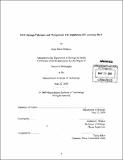| dc.contributor.advisor | Graham C. Walker. | en_US |
| dc.contributor.author | Wiltrout, Mary Ellen | en_US |
| dc.contributor.other | Massachusetts Institute of Technology. Dept. of Biology. | en_US |
| dc.date.accessioned | 2009-10-01T15:58:23Z | |
| dc.date.available | 2009-10-01T15:58:23Z | |
| dc.date.copyright | 2009 | en_US |
| dc.date.issued | 2009 | en_US |
| dc.identifier.uri | http://hdl.handle.net/1721.1/47884 | |
| dc.description | Thesis (Ph. D.)--Massachusetts Institute of Technology, Dept. of Biology, 2009. | en_US |
| dc.description | Includes bibliographical references. | en_US |
| dc.description.abstract | DNA damage constantly challenges the integrity of genetic material during the lifetime of every cell. Accurate duplication of DNA and its proper transmission to a new cell are critical to avoid mutations or loss of genetic information that ultimately may cause altered cellular functions, cell death, or uncontrolled growth as in the case of tumor cells. Fortunately, cells possess a multitude of mechanisms to ensure the fidelity of DNA replication and protect against permanent changes to DNA. These mechanisms divide into the categories of DNA repair and DNA damage tolerance, although some of the proteins involved overlap between both mechanisms. DNA repair restores damaged DNA back to the original, unmodified state. Alternatively, the cell may require DNA damage tolerance to temporarily deal with DNA damage during replication. The altered DNA remains as a result of tolerance and is later a candidate for repair. This work focuses on the DNA damage tolerance pathway of tranlesion synthesis (TLS). TLS involves specialized DNA polymerases with the capacity to bypass DNA lesions that are otherwise inhibitory to replicative polymerases. Specifically, the TLS polymerases, Rev1, Pol [zeta], and Pol [eta], perform TLS in Saccharomyces cerevisiae. In addition to their contribution to cellular survival after DNA damage, Rev1 and Pol [zeta] are responsible for the majority of spontaneous and damage-induced mutagenesis. Thus mutagenesis, at least for Pol [zeta], is a consequence of a catalytic activity with an increased error rate relative to replicative polymerases like Pols [delta] and [epsilon]. | en_US |
| dc.description.abstract | (cont.) Due to the mutagenic nature of Rev1, the cell must regulate the employment of TLS to optimize the benefits of tolerance. One manner this is accomplished in S. cerevisiae is through the cell cycle regulation of Rev1's protein levels. I begin with the study of proteasome-dependent degradation as a means to govern the cell cycle regulation of Rev1 and the non-cell cycle regulated levels of the Rev3 subunit of Pol[zeta]. Next, I describe another layer of regulation involving Rev 's lesion-specific catalytic activity that is otherwise largely ignored in vivo and how the error-free tolerance pathway masks the loss of this function. | en_US |
| dc.description.statementofresponsibility | by Mary Ellen Wiltrout. | en_US |
| dc.format.extent | 208 p. | en_US |
| dc.language.iso | eng | en_US |
| dc.publisher | Massachusetts Institute of Technology | en_US |
| dc.rights | M.I.T. theses are protected by
copyright. They may be viewed from this source for any purpose, but
reproduction or distribution in any format is prohibited without written
permission. See provided URL for inquiries about permission. | en_US |
| dc.rights.uri | http://dspace.mit.edu/handle/1721.1/7582 | en_US |
| dc.subject | Biology. | en_US |
| dc.title | DNA damage tolerance and mutagenesis : the regulation of S. cerevisiae Rev1 | en_US |
| dc.title.alternative | Deoxyribonucleic acid damage tolerance and mutagenesis | en_US |
| dc.title.alternative | Regulation of S. cerevisiae Rev1 | en_US |
| dc.title.alternative | Regulation of Saccharomyces cerevisiae Rev1 | en_US |
| dc.type | Thesis | en_US |
| dc.description.degree | Ph.D. | en_US |
| dc.contributor.department | Massachusetts Institute of Technology. Department of Biology | |
| dc.identifier.oclc | 433134182 | en_US |
